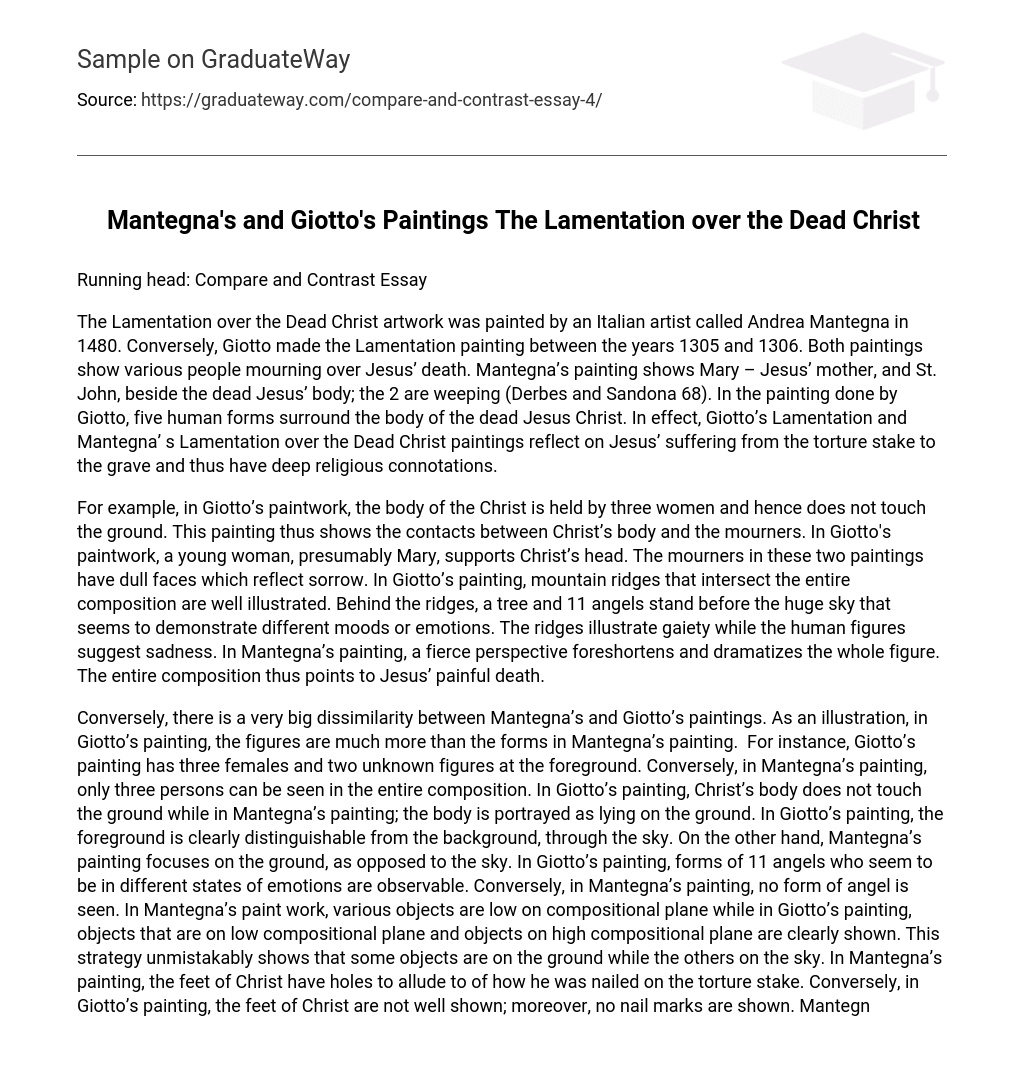The Lamentation over the Dead Christ artwork was painted by Italian artist Andrea Mantegna in 1480. Conversely, Giotto created his Lamentation painting between 1305 and 1306. Both paintings depict various people mourning Jesus’ death. In Mantegna’s painting, Mary (Jesus’ mother) and St. John stand beside Jesus’ dead body, weeping. In Giotto’s painting, five human figures surround the body of the deceased Jesus Christ.
Effectively, both Giotto’s and Mantegna’s Lamentations reflect on Jesus’ suffering from the torture stake to the grave and thus have deep religious connotations.
For example, in Giotto’s painting, the body of Christ is held by three women and does not touch the ground. This painting shows the connection between Christ’s body and the mourners. A young woman, presumably Mary, supports Christ’s head. The mourners in both paintings have dull faces that reflect sorrow. In Giotto’s painting, mountain ridges intersecting the entire composition are well-illustrated. Behind them stand a tree and 11 angels before a vast sky that seems to demonstrate different moods or emotions. The ridges illustrate gaiety while human figures suggest sadness.
In Mantegna’s painting, a fierce perspective foreshortens and dramatizes the whole figure pointing to Jesus’ painful death.
Conversely, there is a significant difference between the paintings of Mantegna and Giotto. For example, in Giotto’s painting, there are more figures than in Mantegna’s painting. In the foreground of Giotto’s painting, there are three females and two unknown figures. On the other hand, only three people can be seen in Mantegna’s composition. Additionally, Christ’s body does not touch the ground in Giotto’s painting while it is portrayed as lying on the ground in Mantegna’s work.
Giotto’s painting clearly distinguishes between foreground and background through the sky while Mantegna focuses on the ground instead of sky. In terms of angels depicted, 11 angels with different emotional states can be observed in Giotto’s painting while no angel form is present in Mantegna’s work.
The compositional plane differs between these two paintings as well; objects that are low on compositional plane and objects high up are clearly shown to indicate some objects being on earth while others are up above. The feet of Christ have holes to allude to how he was nailed to a torture stake which is visible only in Mantegna’s work.
Mantegna seems to have focused more on realism with regard to foreshortening whereas Giotto depicts heaven and earth joining together to mourn their dead savior creating a voluminous three-dimensional world compared to simple window framing-like composition by Mantegna.
In terms of proportionality, Christ’s body appears swollen and big with reduced feet size by Mantega whereas no swelling or disproportionality can be observed from Christ’s body depicted by Giotto.
Mountain ridges that show jagged diagonal lines can be seen only in Giotto’s depiction along with fully covered body compared to partially-dressed one portrayed by Mantegna. Clothing texture appears soft and smooth in Giotto’s painting while it seems rough and torn in Mantegna’s work.
Overall, these characteristics show that Christ endured much suffering from his crucifixion to his death.
These two paintings share similarities as they both depict various entities mourning Christ. In Giotto’s painting and Mantegna’s, the body of dead Christ is encircled by other figures, including Mary and disciple John. The figures surrounding the body of Christ in both paintings appear to be sorrowful, conveying a mood of great sadness. Both paintings are considered Renaissance art and are symbolic, with their respective artists remembered for their exceptional work many years ago.
The use of light contrasted with shadow in both Mantegna’s painting and Giotto’s enhances the realism of the scenes by foreshortening the recumbent figure. The emotional Biblical catastrophe depicted in both paintings is conveyed through pastel colors that complement each other, giving a feeling of stagnation and movement within the picture plane.
Giotto’s painting has rough surfaces surrounding the clothing of its figures, similar to Mantegna’s depiction where Christ’s body lies on a rough surface that arouses feelings of his suffering. Both paintings reflect on Christ’s problems on the cross and his resurrection from death while clearly identifying various figures such as Mary, disciple John, and Jesus himself.
In conclusion, both Mantegna and Giotto created impressive works that will be remembered for generations. Giotto’s paintings appear to be more advanced than Mantegna’s because he includes more figures in his compositions. Giotto’s paintings attempt to convey the message that Christ has risen and fulfilled his earthly mission, while Mantegna’s painting depicts Christ after he has been crucified and taken to the tomb. Both artworks demonstrate the immense suffering that Jesus endured before, during, and after his crucifixion.
Works Cited
Derbes, Anne and Sandona, Mark. The Cambridge Companion to Giotto. Cambridge, UK: Cambridge University Press, 2004.





